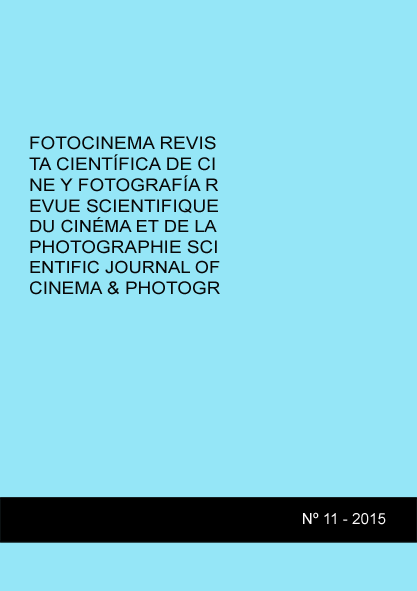Por una semiótica del selfie en la cultura visual digital
DOI:
https://doi.org/10.24310/Fotocinema.2015.v0i11.6081Abstract
En primer lugar, el fenómeno selfie consiste simplemente en volver del revés la sintaxis fotográfica con el fin de hacer coincidir en la misma instancia al fotógrafo y al objeto fotografiado. No obstante, más allá de esta operación, el selfie tiene que ver con el régimen escópico de la sociedad de comienzos del siglo XXI. El presente ensayo analiza un archivo de fotografías digitales tomadas y publicadas en Internet durante el año 2014, todas ellas compuestas de acuerdo con esta estructura enunciativa auto-consciente. En último término, se tratará de establecer una tipología cultural semiótica en torno a la estructura del ver y del ser visto a través de la web 2.0.
Abstract:
First of all, the selfie phenomena consists on turning inside the photoghraphic syntax, in order to concentrate into the same instance the photographer and the object of the photography. In addition to this, it has to deal with the visual structure of the society at the begining of the XXIst century. On that way, this essay may analyze some digital pictures which has been taken and published on the Internet during the year 2014 which have been composed according to this self conscient enunciation. At least we may be able to build a semiotic cultural typology about the structure of watching and being watched through the web 2.0.
Palabras clave:
selfie; sí mismo; cultura visual digital; fotografía digital; panopticon; semiótica.
Keywords:
Selfie; Self; Visual Digital Culture; Digital Photography; Panopticon; Semiotics.
Downloads
Metrics
Downloads
Published
How to Cite
Issue
Section
License
All contents published in Fotocinema Revista científica de cine y fotografía are protected under the Creative Commons Attribution-NonCommercial-ShareAlike 4.0 International (CC BY-NC-SA 4.0) license. All about this license is available in the following link: <http://creativecommons.org/licenses/by-nc-sa/4.0>
Users can copy, use, redistribute, share and exhibit publicly as long as:
- The original source and authorship of the material are cited (Journal, Publisher and URL of the work).
- It is not used for comercial purposes.
- The existence of the license and its especifications are mentioned.
There are two sets of authors’ rights: moral and property rights. Moral rights are perpetual prerogatives, unrenounceable, not-transferable, unalienable, imprescriptible and inembargable. According to authors’ rights legislation, Fotocinema. Revista científica de cine y fotografía recognizes and respects authors moral rights, as well as the ownership of property rights, which will be transferred to University of Malaga in open access. The property rights are referred to the benefits that are gained by the use or the dissemination of works. Fotocinema. Revista científica de cine y fotografía is published in an open access form and it is exclusively licenced by any means for doing or authorising distribution, dissemination, reproduction, , adaptation, translation or arrangement of works.
Authors are responsable for obtaining the necessary permission to use copyrighted images.













13.png)




